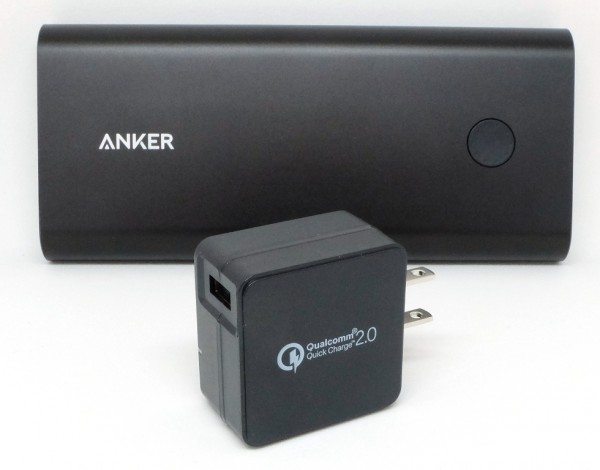
When you think of 26,800 mAh battery, do you think “Do I really need that much battery”? However, what if the power goes out for days? This is an unusual scenario, but it happens. You may also want to have a large portable battery when you’re camping or when you travel for business for a few days so that you don’t have to worry about having to find an outlet to recharge your devices. These are a few of the instances when having a 26,000 mAh battery would come in handy. The Anker PowerCore+ 26,800 & Quick Charge 2.0 USB Wall Charger is a large portable battery that has a single Quick Charge 2.0 (QC 2.0) USB port to charge your QC 2.0 compatible devices and two other fast charging USB ports to charge other devices at the same time. The battery itself is capable of being charged at 9V/2A which means it charges in half the time that other batteries of this size would charge. The product I was given to review was a package deal – it also came with a QC 2.0 USB wall charger. The battery and wall charger performed very well in my tests with the only drawbacks being size, cost and no support for pass-through charging.
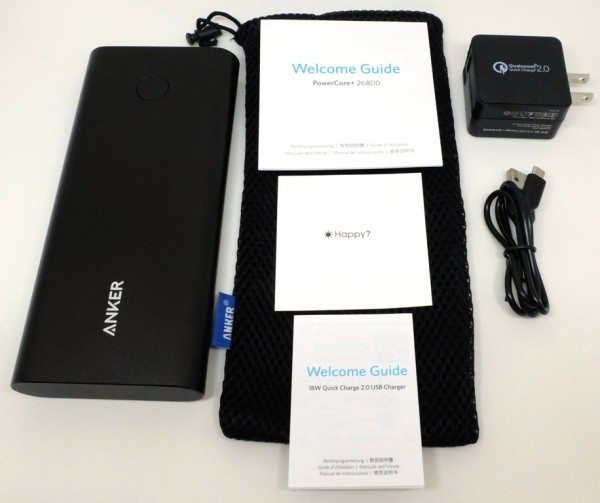
Package Contents:
- Anker PowerCore+ 26800 (model A1372)
- Quick Charge 2.0 USB Wall Charger (A2130)
- micro-USB cable
- Travel pouch
- Welcome guides for the PowerCore+ 26,800 battery and 18 Watt Quick Charge 2.0 charger
- Satisfaction card
Technical Specifications
- Capacity: 26,800mAh, 96.48Wh
- Input: 5V/2A, 9V/2A
- Normal Output (two USB charging ports): 5V/2.4A each
- QC 2.0 Output (one USB port): 5V/2.4A, 9V/2A, 12V/1.5A
Design & Build Quality
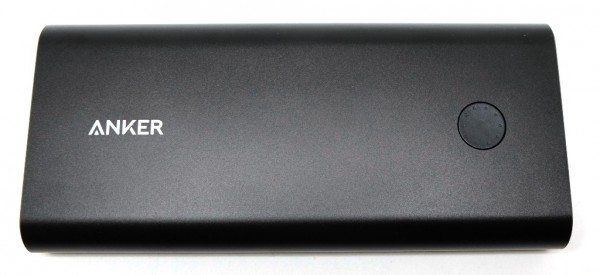
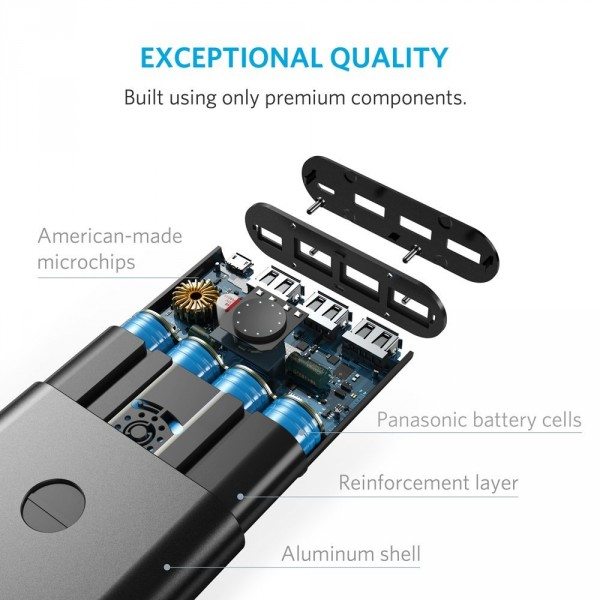
Anker has a reputation for building quality devices and this portable battery appears to be no different. This huge 26,800 mAh battery has a smooth matte aluminum exterior with curved sides which make it comfortable to carry. It is quite a large battery (7″ L x 3.125″ W x 1″ D) and hefty too, weighing 1.3 pounds (590g).
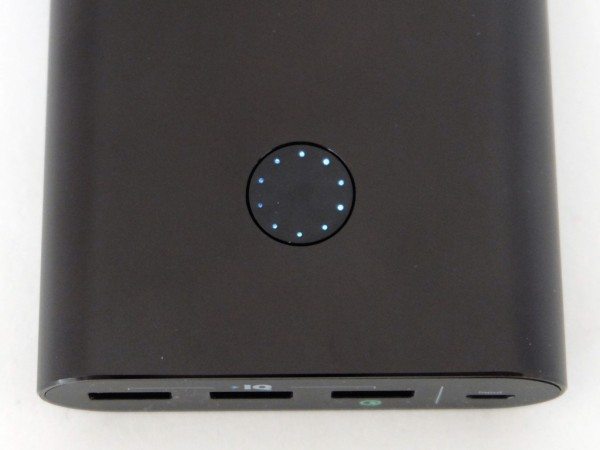
The front of the battery has a circular button that contains 10 LED lights indicating the level of charge left.

The battery has one QC 2.0 port (as indicated by the green lightning bolt icon under the port) to charge your QC 2.0 compatible devices. Since QC 2.0 is backward compatible, it may be used to charge any of your devices. There are two other ports available as well and all the ports use Anker’s PowerIQ and VoltageBoost technology to deliver optimal voltage and current to your devices. Thus, you could charge up to three devices at one time using this battery. There is a micro-USB port available to charge the battery that has the ability to charge twice as fast as other batteries of the same capacity.
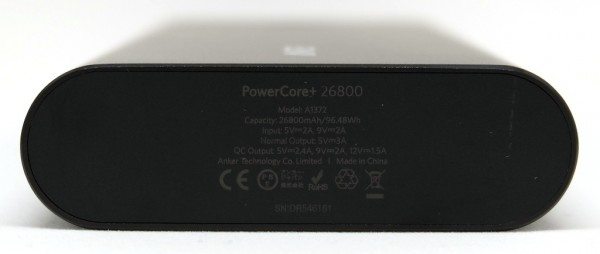
The bottom of the battery lists its specifications. This is a 96.48Wh battery which is safe to take with you on a plane. When flying, each portable battery that you travel with must be under 100Wh according to the FAA.
Use

Initial observations and cable tests: The above photo illustrates just how big the battery is (7″ L x 3.125″ W x 1″ D) when compared to my 6-inch Nexus 6 phone. Before proceeding with my battery tests, all cables used with this battery and wall charger were tested with my DROK USB multimeter to make sure that they were able to deliver the full wattage for my devices. When testing the battery, in general, the battery starts charging immediately after plugging in any device. On a couple of occasions, I had to press the battery’s button to start the charging process (perhaps this was because I left the cables plugged into the battery when it was not charging any device). After plugging in my devices to charge, the LEDs on the battery remained lit to indicate that the battery was charging. The number of LEDs that were lit indicated how much charge was left.
Nexus 6 tests: When plugging in my Nexus 6 phone into the QC 2.0 port, I found that it was charging at 8.84V/1.45A/12.81W which is slightly lower than my OEM wall charger which is typically 9.11V/1.44A/13.11W. In five tests, when the battery on my phone reached 3-5%, I charged it using the Anker battery and on the first three charges, my phone charged in 1:57 (hh:mm), 2:04, and 2:08, but on the last two charges it charged in 1:52, and 1:45. Thus, it would appear that this portable charger charges just about as quickly as when using the OEM charger (OEM: 1:53 and 1:52 when starting at 4-5%).
I had a problem with the battery charging a device only once. I connected my phone to the battery for charging and initially it looked like everything was fine. When I checked two hours later, I found that the battery was not charging the phone even after I pressed the battery’s LED button and disconnected and reconnected my phone. After plugging in my phone to another charger then plugging it back into the battery, everything was fine again. I have not had the problem since.
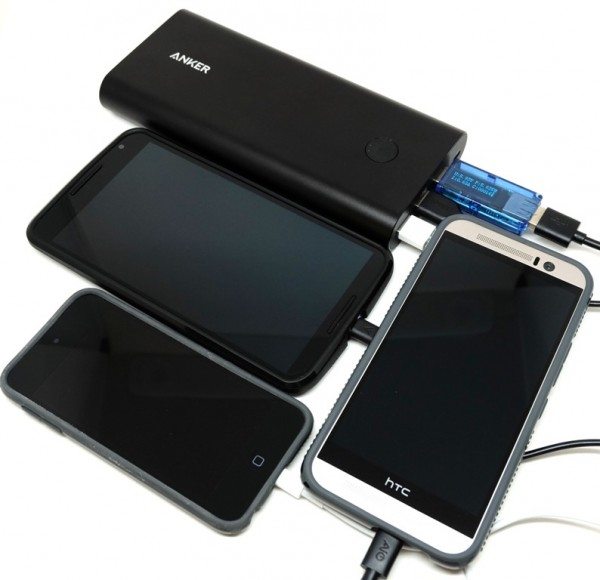
HTC One M9 tests: When charging a QC 2.0 device like the HTC One M9 phone using one of the normal ports, it charges at 5.21V/1.45A/7.56W versus 8.82V/1.33A/11.73W using the QC 2.0 USB port. Like the Nexus 6, charging this phone using the QC 2.0 port was essentially the same as when charging with my Nexus 6 charging adapter (1:50 when starting at 3% using the battery versus 1:46 when starting at 5% using the adapter). The HTC One M9 did not come with a QC 2.0 AC adapter so I compare portable batteries other chargers that I review to the HTC One M9 using my Motorola Nexus 6 OEM QC 2.0 charger.
iOS devices’ tests: I also charged an iPad Mini 4 and an iPod Touch 5G using this battery. First I was curious about whether there was any difference in charging power when plugging my iOS devices into the normal charging ports versus the QC 2.0 charging port. I found that there was no difference. When comparing the charging of the Anker battery to the Apple’s OEM chargers, I found that my iPod charged in the same amount of time as its OEM charger (0:43 when starting at 12% using the battery versus 0:41 when starting at 12% using its OEM charger). In one test, the iPad Mini 4 took a little longer to charge using the battery in one test (3:54 when starting at 3% using the battery versus 3:35 when starting at 4% using its OEM charger), but another test revealed that it charged slightly faster (3:27 when starting at 4%).
The number of devices charged on one charge of the battery: In addition to testing the how quickly the battery charged my devices, I wanted to see how many charges I would receive out of one charge of the battery. The Anker website indicates that this battery will charge an iPhone 6 (1810 mAh) ten times, a Galaxy S6 (2550 mAh) over seven times, and a 2015 Macbook (5263 mAh or 39.71Wh/7.55V) over three times. I don’t have any of those devices but I found in my tests that I could charge my Nexus 6 phone (3220 mAh) five times and my iPod (1030 mAh) once on one charge of the battery. In another test, I found that I could fully charge my Nexus 6 twice, HTC One M9 (2840 mAh) once, an iPad Mini 4 (5124 mAh) once, and an iPad Mini (4440 mAh) up to 44% before the battery went dead.
Charging the battery: When testing how quickly the battery itself could be charged, I found that it took only 8.75 hours to fully charge it using the included Anker QC 2.0 18W Wall Charger and cable. That is really quite fast for a battery this size.
Pass-through charging: This battery is not capable of pass-through charging (when a battery is able to charge a device while at the same time being charged). If any device was connected to the battery to charge and then the battery itself is plugged into a wall charger, all of the devices connected to it stopped charging.
Quick Charge 2.0 Wall Charger
Design & Build Quality
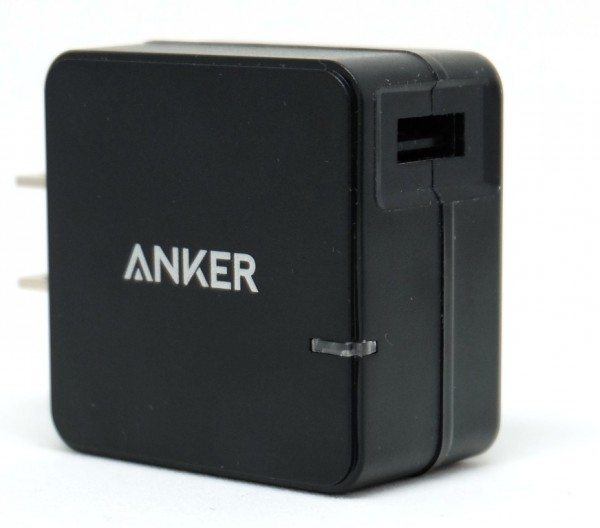
The Anker PowerCore+ 26800 mAh battery came with a Quick Charge 2.0 Wall Charger which is a wonderful addition since most batteries do not come with a wall charger at all. The PowerCore+ 26800 is capable of taking advantage of the QC 2.0 charging technology and thus, Anker provides this wall charger to charge the battery as quickly as possible.
The wall charger is made of black matte plastic and has an LED indicator light to inform you when it is plugged in.
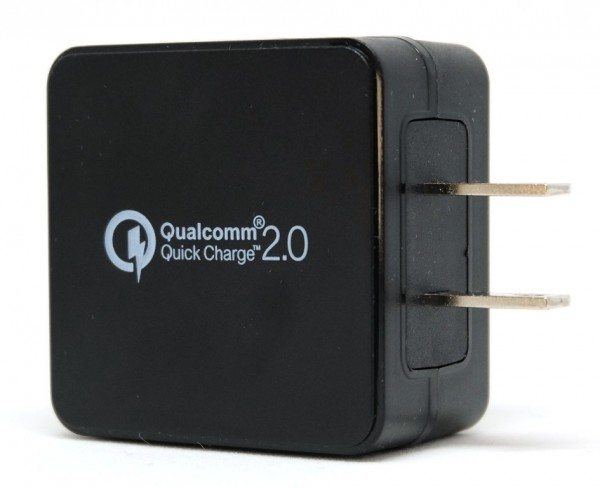
This charger can also be used as an additional charger for your QC 2.0 compatible devices.
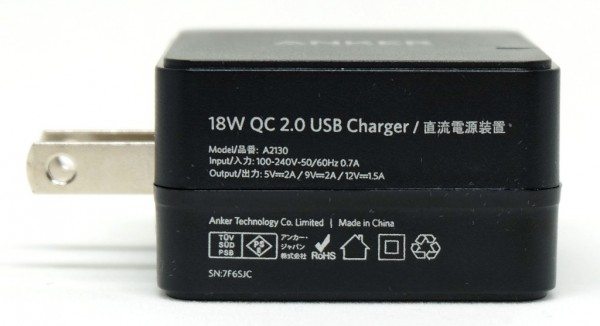
It has an 18W capacity and will output 5V/2A, 9V/2A, or 12V/1.5A.
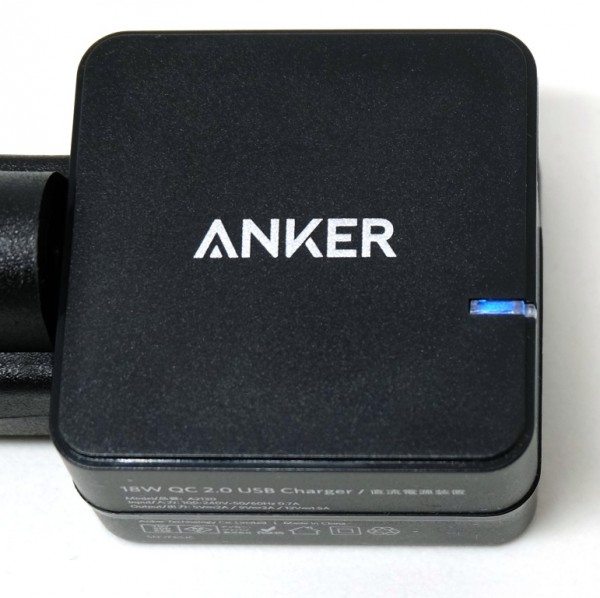
When plugged in, the charger’s LED shines blue.
Use
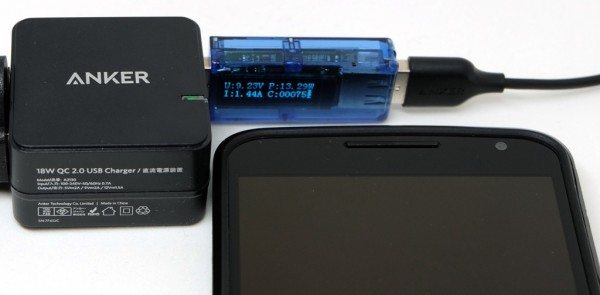
LED status light: When the wall charger is plugged into an outlet without any devices connected to it, the LED light shines blue. When you plug in a QC 2.0 compatible device, the charger’s LED status light turns green. However, when plugging in a non-QC 2.0 device, the LED remains blue. This light does not turn off or change to a different color when charging is complete, thus, it is only an indicator that the charger is plugged in or that a QC 2.0 device is plugged into it.
Tests: When testing the Anker Quick Charge 2.0 Wall Charger, I found that it charged the PowerCore+ 26800 mAh battery in 8.75 hours (9.12V/1.96A/17.87W). And when used with my two QC 2.0 compatible devices it charged them in approximately the same time as their OEM chargers. I tested my Nexus 6 twice with it and found that it fully charged my phone (9.25V/1.44A/13.32W) in 1:45 when starting at 11% charge and 1:56 when starting at a 2% charge (OEM: 1:53, 1:52). It also charged the HTC One M9 phone in 1:48 when starting at 1% versus 1:46 when starting at 5% when using my Motorola QC 2.0 charger (remember, this phone did not come with its own charger). When testing it with a non-QC 2.0 device, my iPod Touch 5G, it charged in 0:47 when starting at 12% which is a little slower than its OEM charger (0:41 when starting at 12%).
Conclusion
The Anker PowerCore+ 26800 and Quick Charge 2.0 Wall Charger are wonderful chargers that performed very well in my tests. Both charged my QC 2.0 devices in about the same time as the devices’ OEM chargers. I found in tests using non-QC 2.0 devices that it charged my iPod Touch 5G just as fast as its OEM charger but was a little slower when charging the iPad Mini 4 in one test while in another test it charged slightly faster. The battery itself charged in 8.75 hours which is very impressive for a battery this size. On one charge of the battery, I was able to charge my Nexus 6 five times and my iPod Touch 5G once. In another test, the battery was able to charge my Nexus 6 twice, an HTC One M9 once, iPad Mini 4 once, and partially charge an iPad Mini.
Overall, I would say that Anker has made another quality product and if you are looking for a portable battery with a large capacity for travel or emergency purposes and you can get over the sticker shock ($79.99 from Amazon), then this battery is a wonderful choice. NOTE: During the writing of this review Anker has since upgraded the wall charger to a QC 3.0 wall charger and no longer sells the battery with the QC 2.0 wall charger which is reflected in the above price. So, perhaps that makes the price a little more palatable?
Updates 08/08/16
This is a very handy portable charger, especially when you need to charge several large devices with large batteries. This particular portable battery is very well made and durable. I love using it and think that it is advisable for everyone to have at least one large battery like this on hand in case of emergencies.
Source: The sample used in this review was provided by Anker. Please visit their website for more information or Amazon to purchase one for yourself.
Apple iPhone FineWoven Wallet with MagSafe – Black
15% OffESR for MagSafe Wallet with Stand, RFID Blocking with MagSafe Ring, 5 Card Holder for Phone Case, Slim Leather Magnetic Wallet for iPhone 17/16/15/14/13/12 Series(Not for Mini), Selected Samsung,Black
33% OffProduct Information
| Price: | $79.99 |
| Manufacturer: | Anker Technology Co. Limited |
| Retailer: | Amazon |
| Pros: |
|
| Cons: |
|



Gadgeteer Comment Policy - Please read before commenting
I have the USB C version of this charger. 2 Standard high speed quick charging ports, and one Quick Charge USB-C port.
I just spent 10 days away from home on a cruise ship and traveling all around Alaska and Canada. I charged this before I left. I took with me my iPhone 6s, AT&T MiFi, a handheld game console, and Lenovo ThinkPad X1. Unfortunately the only charge I can get to charge my ThinkPad is it’s own, but I used the Anker to keep everything else charged the entire 10 days with about 20% left at end of trip. I was very impressed.